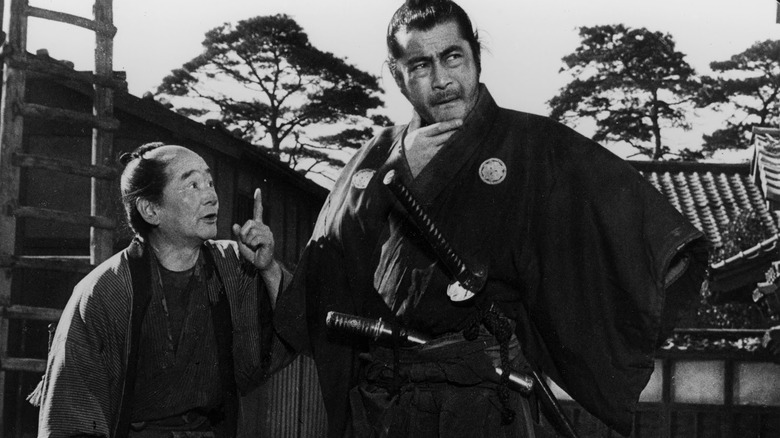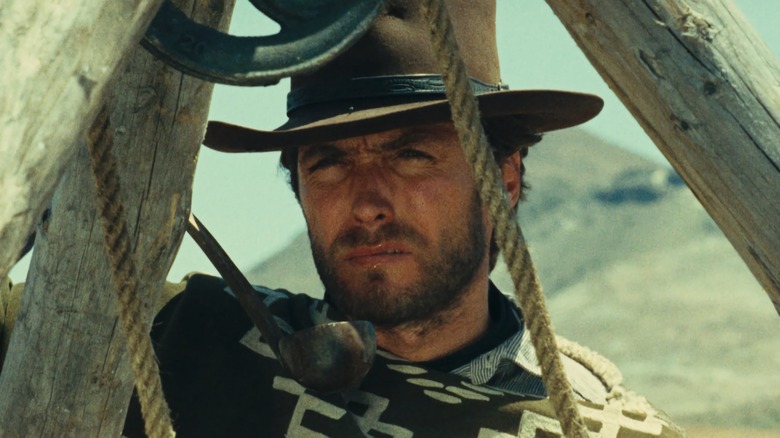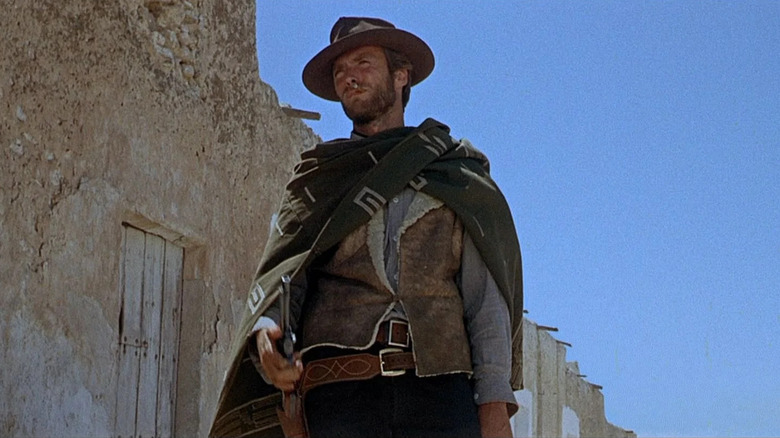A Fistful Of Dollars' Yojimbo Roots Convinced Clint Eastwood It Could Never Be Made In America
In Stuart Galbraith IV's invaluable and exhaustive 2001 book "The Emperor and the Wolf: The Lives and Films of Akira Kurosawa and Toshiro Mifune," the famed Japanese director talks briefly about Sergio Leone's classic 1964 Western "A Fistful of Dollars." Kurosawa admired the film saying that it was "a fine movie," and hastened to add, "but it was my movie."
"A Fistful of Dollars" was, of course, a remake of Kurosawa's own 1961 film "Yojimbo." Both films are about stalwart and detached loners who find themselves wandering through a remote frontier villages that have been overtaken by two warring gangs. In both films, the stranger — Mifune in the original, Clint Eastwood in the remake — use their wits to pit the two gangs against one another. Notably, Leone's film didn't bother to credit Kurosawa or his "Yojimbo" co-screenwriter Ryuzo Kikushima, nor did he approach Toho about the possibility of licensing the rights. Kurosawa rightly sued, and was able to secure $100,000 in compensation, as well as 15% of the film's total grosses. There is a legal line, it seems, between "paying homage" and "ripping off."
In the 1999 book "Clint Eastwood: Interviews," edited by Robert E. Kapsis and Kathie Coblentz, the star of "Fistful" revealed that he and the filmmakers knew that it was a remake of "Yojimbo," and that he was actually modeling a lot of his performance on Mifune's. Indeed, Eastwood was excited to work on the film specifically because he had already seen the Japanese original, and felt that Leone was one of the few with the nerve to make a Western as stylized as Kurosawa's muscular film.
'Yojimbo, which it was stolen or taken from'
When interviewer Patrick McGilligan asked Eastwood in 1974 about his performance as Joe (not his real name) in "Fistful," the actor said he was particularly intrigued by the character's mysterious qualities. Eastwood claims to have removed a lot of Joe's dialogue from the script prior to shooting, leaving the character more laconic and, eventually, tantalizing for viewers. "You are mystified by him," Eastwood said. He also admitted out loud that Mifune was a direct inspiration, and acknowledged that everyone knew what they were doing. "It was played approximately the same way in 'Yojimbo,'" he said, "which it was stolen or taken from."
When Gilligan asked him about whether or not "Yojimbo" was a remake, Eastwood admitted that it definitely was. But rather than dwell on legal matters, Eastwood pointed out that making the film in Europe was a requirement, as American directors would not have had the gall to do it at all. He said:
"There was never any doubt. When we got over there, they told me it was a re-make of 'Yojimbo.' I said fine. When I first saw 'Yojimbo,' I thought, geez, this would make a great Western, only nobody would ever have the nerve to make it with this style. And then when the script came through several years later, I thought this might be an interesting project. A European might not be afraid of it — like Leone — where an American would be afraid of approaching a western such as 'Fistful of Dollars' with that kind of style."
In the United States, meanwhile, John Ford was making more broadly appealing studio pictures like "How the West Was Won." American Westerns didn't have the same cynical style at the time.
Shooting violence
Eastwood went into more detail as by what he meant when it came to American directors not having courage to shoot films like "Fistful." Eastwood cited some old taboos about violence on screen, leftover from the self-censoring days of the Hays Code, a precursor to the MPA's letter-rating system. The Code had been put into effect in 1934, and while it wouldn't technically be dismantled until 1968, public respect of it was very much on the wane. An Italian filmmaker, then, could finally film gunfire in a more exciting way, and not give a single thought to moribund censorship rules from a generation ago. In short, Leone could finally film bullet impacts. As Eastwood put it:
"[T]here were rule[s] in Hollywood years ago — unspoken rules — that you never tied-up shots of a person being shot. In other words, you never shot a tie-up shot of a man shooting a gun and another person getting hit. It's a Hays Office rule from years ago, a censorship deal. You'd cut to the guy shooting, and then cut to a guy falling. That was alright — the same thing — the public isn't counting the cut. But you could never do a tie-up."
Leone didn't know about the Hays Code, Eastwood didn't care about it, guns were fired, and a classic was born. As Eastwood said:
"We did because Sergio didn't know all that. He wasn't bothered by that. Neither was I. I knew about it but I couldn't care less. The whole object of doing a film with a European director was to put a new shade of light on it."
While it wasn't new — it started years before in Japan — it did become a notable film. In 2022, both films are celebrated as classics.


